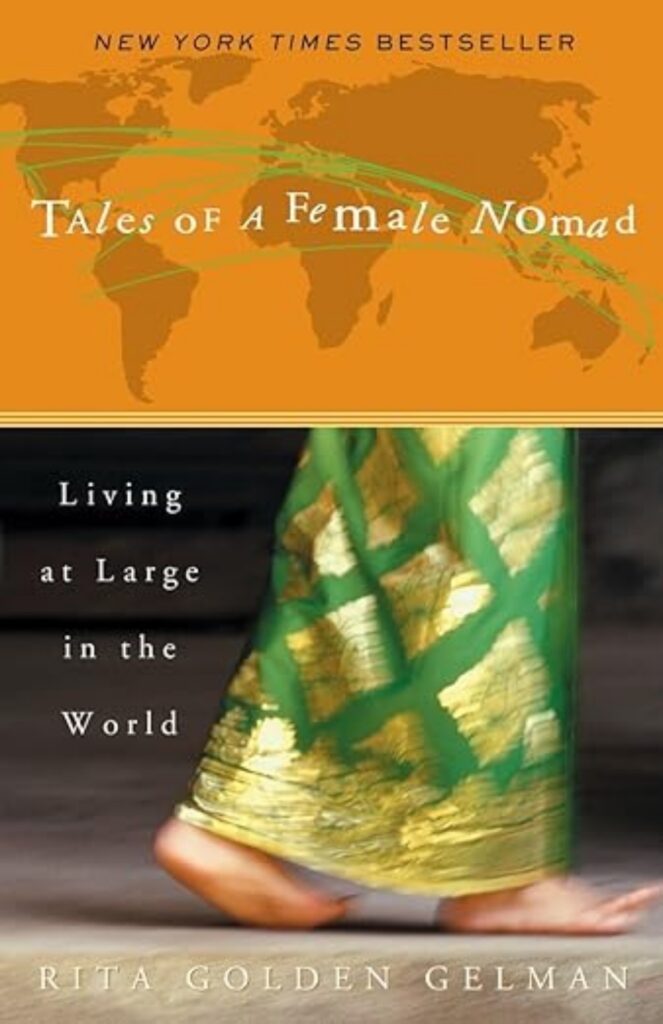
Tales of a Female Nomad by Rita Golden Gelman
Tales of a Female Nomad follows Rita Gelman through a series of transformative adventures around the world. Here’s why I think you’ll be inspired by it.

Summary:
Rita’s current life opposes the life she’d prefer. She’s an informal and venturesome woman caged in a stuffy L.A. marriage. As the stability of her marriage drifts behind she allows her curiosity to lead her to a more authentic future. Through her initial solo travels, she’s able to discover who she is when she’s not beside her husband. She fulfills her new desires as an Anthropology grad student and finds herself completing her dissertation in Mexico all while dreading her looming divorce.
Rita’s catalytic trip to Mexico reveals a version of herself that would soon change. She struggles with finding normalcy and comfort in being seen alone and having independence. She overexerts herself with strangers in a desperate attempt to acquire fast friends. As if circumstances couldn’t get more uncomfortable, she experiences the onset of Stevens-Johnson syndrome. However, she’s reflective enough to realize it symbolizes the start of a rebirth for her. As her skin flakes and sheds she rediscovers her identity as Rita and not an L.A. wife. From then on she permits herself to live authentically.
While everyone thinks she is running away from life, she knows she is running towards life. She has no husband, no possessions, and no limitations. Living off of her royalties as a writer finances the nomadic lifestyle she dreams of that would introduce her to her newfound confidence. No longer a self-conscious clinger, she harnesses her intuitive and social skills to get her to the right places and people. Exhilarating experiences emanate from her new life including shrooms in Palenque, singing sessions with native Papua New guineas, and deep diving in Lombok.
From Rita’s spiritual and cultural lessons, she understands life cycles and applies them to her relationships with her adult children and aging parents. She witnesses old age, death, and the spirit world which propels her to honor her elders and nourish the youth. She discovers cultures that may be technologically bare but spiritually full which grants opportunities to connect with and appreciate nature and community. It’s these lessons that leave Rita self-assured on how she wants to live; present, as she was with everyone she met.

Analysis:
As Rita takes readers through themes of transformation and discovery, she clearly wants readers to gain an optimistic perspective of life’s inevitable changes. Amid Rita’s life changes she challenges her comfort zones through divorce, independence, and travel to discover a new world of community and culture. Rita succeeds in enticing readers into the magic of what following one’s joy can lead to. Through her serendipitous travels, she offers readers a dose of courage to rediscover passion.
Her plot starting with her divorce presents cycles of fear and trust that appear before each new venture she takes on. As her ability to trust becomes stronger than fear, she is noticeably transformed into a woman who can navigate life independently with her innate gifts of intuition and amiability.
Connecting with others wasn’t just her desire but also crucial to being accepted in the communities she entered. Through her reflective nature, she realizes she can’t be loyal to her ethnographic training. She can’t separate her emotions from her practice. She learns to utilize her flexibility when she realizes that the more she adapts to cultural ways the more she’s accepted. Since Rita’s travelogue is mostly set in the ’80s and ’90s readers will observe how travelers connect and keep in touch; through letters and eventually emails. The lack of technology meant more initiated conversations that blossom into new friendships.
Although the first half of Rita’s travels exudes a tone of newness and wonder, she experiences new depths of travel through spirituality when she arrives in Bali. Her arrival in Bali starts the climax of her story as she will stay for 8 transformative years.
Rita’s present tense deliverance in sharing her experiences is straightforward which leaves out detailed analyses and descriptions. Her simplistic voice adds a casual style while still including evocative imagery. While her most scenic moments were in Bali, I have to give an honorable mention to her Orangutan Camp visit in Borneo and her Papua New Guinea trip. Her river trip to the Orangutan Camp itself was alluring enough as she spotted orangutans in the dark shadowy trees of the forest. A greeting smile from both groups enhances her captivating encounter with a hunter-gatherer group in Western New Guinea; which ensures Rita that smiling is a universal language.

Evaluation:
Rita’s background in anthropology and writing grants her leverage in analyzing and writing about cultural experiences. However, she focuses more on her emotional reactions to culture than an informative tone of it. Therefore, I would’ve liked a more in-depth narration of Rita’s subjective experiences. At times her thoughts are so plain-spoken that it leaves readers to wonder or fill in the blanks of how she truly felt.
Rita credits her travel successes with following her intuition and cultivating connections with everyone she meets. Some may view Rita’s journey as riddled with streaks of luck as opposed to her trusting her inner guidance. Others may see her cultivated connections as strategic charm to get her where she needs to be. Although her fortunate travels may seem unrealistic her intuitive nature is beneficial as she guides herself to people who provide her with unforgettable experiences. Rita’s determination to cultivate connections adds a valuable lesson in people skills and vulnerability.
As a White American who grew up in a privileged LA life there is potential for cultural bias which is presented in some offputting judgments towards foreigners. Felipe for example, was Rita’s host on the Galapagos Island. He was also a PhD biologist which was hard for Rita to conceptualize because he looked like a “farm worker.”(99). Their chemistry grows as he continues to host and teach her about the island’s volcanic landscape. Surprisingly, she ends up having sex with him but can’t understand how an “Ecuadorian peasant” looking man sparked attraction in her (101)…This was the disappointing aspect of her writing and thought process and I would’ve preferred to have read a more open-minded response to some of her encounters.
Spirituality-wise, her shock and confusion with spiritual experiences in Bali expose the lack of spiritual depth in the Western world. As someone with an Afro-Caribbean ethnic background, it was amusing to read Rita and her daughter struggle to grasp the realities of spirit possession, ancestors, and an afterlife; concepts that my cultural and ancestral background are very familiar with.

An aspect of female solo travel that could’ve been discussed more would be safety. Rita has experienced dangerous encounters in her travels such as domestic violence and alcoholism in Oaxaca, and a road trip through El Salvador during a civil war to get to Nicaragua; a rival country.
Conclusion:
Tales of a Female Nomad is a fun choice for an eventful dose of adventure and growth. If you’re interested in seeing how Rita’s adventures continue check out her blog, http://www.ritagolden1gelman.com/. Viewing the images she presents of the travels from her book provided the closure I didn’t know I needed!





